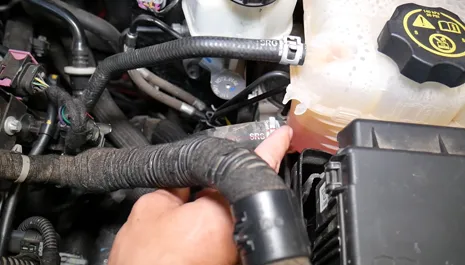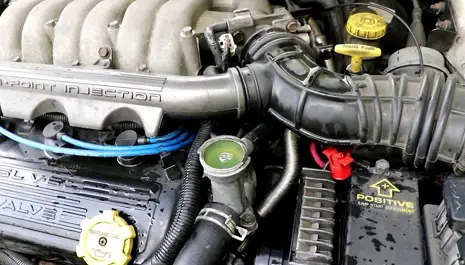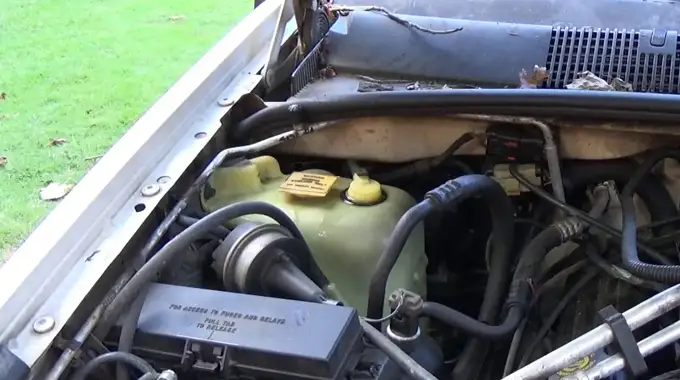Last Updated on March 19, 2023
When your coolant reservoir boils, it is typically a sign that your cooling system is not functioning correctly. If the coolant is not circulated properly, it can overheat and cause the engine to seize up. In severe cases, this can lead to engine failure.
Boiling coolant can also cause the radiator to crack, resulting in leaks. This can be a scary situation, especially if you’re unsure what to do. You may now be wondering why this is happening.
There are a few reasons why your coolant reservoir may be boiling. The answer depends on the severity of the problem, and whether or not you catch it in time, so it isn’t easy to give a specific answer.
But don’t worry, we’re here to help. The following article will explain why is my coolant reservoir boiling and how you can fix it.
Why is My Coolant Reservoir Boiling : Main Reasons

There are many possible reasons why your coolant reservoir is boiling, and it’s important to get to the bottom of the problem as soon as possible. Here are a few different reasons why this could be happening.
1. Overheating
The water in your radiator evaporates when your engine overheats, causing a buildup of pressure within it. It can result in a system’s failure, which can cause your cooling system to boil over. If you have an overheating problem, it’s essential to have it fixed quickly to avoid damage to your engine.
2. Incorrect Coolant Mix
Another reason your coolant reservoir might be boiling is that the coolant mix is incorrect. If the ratio of water to antifreeze is off, it can cause the coolant to overheat and boil.
Be sure always to use the correct water-antifreeze ratio when topping off your fluids. Using the right type of antifreeze for your car is also essential. If you’re unsure, please refer to the owner’s manual or ask a mechanic.
3. Leaks
Even a tiny leak will cause the coolant level to drop, leading to overheating. You should check for leaks as soon as possible and repair them as needed. Be sure to also check the hoses and clamps for any signs of wear or damage.
Whenever you find leaks, be sure to fix them immediately. Be sure to keep an eye on your coolant levels and top off the reservoir as needed.
4. Faulty Thermostat
A faulty thermostat can also lead to a boiling coolant reservoir. If the thermostat is stuck in the “open” position, it will allow coolant to flow through your engine too quickly, causing it to overheat.
On the other hand, if the thermostat remains in the “closed” position, it will prevent cooling liquid from circulating properly, also leading to overheating.
5. Low Coolant Level
If your coolant level is low, it can cause your engine to overheat. It is because there is not enough liquid to absorb the heat generated by the engine.
Whenever the coolant level gets too low, it will cause the radiator water to boil, which will then cause the coolant reservoir to boiling over. Be sure to monitor the coolant level regularly.
6. Pressure Buildup
Boiling coolant can happen whenever there’s too much pressure in your cooling system. Many things can cause this, such as a stuck thermostat or a malfunctioning radiator cap.
If you notice that the level of your coolant is rising, it could indicate a pressure buildup. Be sure to have your system checked by a mechanic so that they can determine the cause of the pressure and fix it.
How to Fix a Boiling Coolant Reservoir?

Fixing a boiling coolant reservoir is a relatively simple task that anyone can do with the right tools and materials. Here’s a step-by-step guide on what to do when a coolant reservoir boils:
Step 1: Locate the Coolant Reservoir
Essentially, a coolant reservoir is an additional small plastic tank that holds extra coolant for your car. On the passenger side of the engine bay, it is usually near the radiator.
The coolant reservoir will have a fill line marked on it, as well as a low coolant indicator. When the coolant level in the pool is below the fill line, your car may be at risk of overheating.
Step 2: Check the Level
If you find that coolant levels are low, you will need to add more coolant. Be sure to use a 50/50 mix of water and coolant, as using 100% coolant can damage your engine.
You can buy pre-mixed coolant or mix it yourself using distilled water and coolant concentrate. Once you’ve added enough coolant to bring the level up to the fill line, screw the cap back on tightly and replace any clips or fasteners holding it in place.
Step 3: Inspect the Hoses for Leaks
First, check the radiator hose for any cracks or holes. If you find any, replace the hose immediately. Next, check the hose that goes from the radiator to the coolant reservoir. This hose is under a lot of pressure, so that any leak can cause problems.
In case of a leak, try to repair it with some duct tape or a similar product. If the leak is too big to be fixed, you’ll need to replace the hose. Finally, inspect the hose connecting it to the engine block.
Under this hose, there is less pressure than in the other two, so a small leak is not as severe. If you discover a significant leak, you’ll need to have it repaired or replaced.
Step 4: Inspect the Cap and Radiator for Leaks
Ensure that you check the radiator and cap for leaks regularly. The first step is to remove the cap from the radiator. Once the cap is off, visually inspect the radiator to see if there are any cracks or leaks. In case of any, it is essential to have them repaired instantly.
You should also check the condition of the gasket on the bottom of the cap. If it is damaged, it has to be repaired. Once you have inspected the radiator and fan, please put it back together and tighten it until it is snug.
If your radiator is leaking, you may be able to fix the leak with some radiator-stop leak temporarily. This product will not fix a large hole, but it can help to seal small leaks. The package includes instructions, so make sure you follow them.
Step 5: Pressure Test the Cooling System
If there are no leaks, you can pressure inspect the cooling system to ensure there are no hidden leaks. Auto parts stores sell pressure testers that can be rented or rented to ensure the cooling system is working correctly. Attach the pressure tester to the radiator filler neck and pump it up to the recommended pressure.
Start the engine and let it run for several minutes. Then, turn off the engine and check for leaks. When no leaks are found, remove the pressure tester and add coolant to the radiator.
Start the engine again to allow it to run until it reaches operating temperature. The boiling coolant reservoir should be fixed now. If not, repeat this process until it is fixed.
Step 6: Replace the Coolant Reservoir Cap and Hoses
To replace coolant reservoir caps and hoses, you must remove the old ones first. Make sure to clean any residue or grime from the hoses and cap before proceeding.
Next, install the new hoses and cap. Please make sure they are tight so that leaks do not occur. Finally, fill the coolant reservoir with fresh coolant, then inspect for leaks again. If everything looks good, you should be good to go.
Step 7: Refill the Coolant Reservoir
If your coolant reservoir is empty, you’ll need to refill it before you can continue using your car. Open the hood and look in the coolant reservoir. In most cases, you will find it inside a radiator. In most cases, you will find it inside a radiator. Once you’ve seen it, remove the cap and slowly pour in coolant until the pool is entire.
Be careful not to overfill it, as this can cause problems down the line. If you’re unsure how much coolant to use, consult your owner’s manual or a mechanic. With the coolant reservoir full, replace the cap and close the hood. Your car should now be back up and running.
FAQs
How Do I Know If My Cooling System is Leaking?

You should check your coolant level regularly. If it’s low, that’s an indication of a leak somewhere in the system. You can also look for leaks by checking for wetness or corrosion around hoses, clamps, and other coolant system components.
If you see any of these signs, ensure your cooling system is inspected by a qualified mechanic immediately. Unaddressed, a cooling system leak may result in engine overheating and severe damage.
How Can I Prevent My Coolant Reservoir From Boiling in The Future?
There are a few things you can do to prevent this from happening. First, make sure that the coolant level is topped off. Coolant that’s below the recommended level makes the engine run hotter, causing boiling. Second, take a look at the radiator hoses.
If they are cracked or leaking, they will need to be replaced. Finally, have the cooling system flushed and refilled with fresh coolant every two years.
Is it Normal For My Coolant Reservoir to be Hot?
It is not uncommon for coolant reservoirs to be hot. It is perfectly normal. When the engine is running, the coolant reservoir gets quite hot since it is close to the engine. The heat from the engine transfers through the coolant reservoir, causing it to become hot.
Although, this heat does not affect the coolant itself and will not cause any problems with the car’s cooling system. So if you notice the reservoir is hot, there is no need to worry.
What are The Symptoms of a Failing Thermostat?
Several symptoms may indicate a failing thermostat. One is frequent cycling, where the furnace or air conditioner turns on and off more often than usual. This can be caused by several issues, including a dirty air filter or a problem with the electrical connection.
Another symptom is inconsistent temperatures, where the temperature fluctuates wildly even when the thermostat is set to a specific temperature. Often, this is the result of a faulty sensor or a loose wire.
If you notice any of these symptoms, it’s essential to call a qualified technician for diagnosis and repair. Ignoring the problem could lead to further damage or even a complete system failure.
What are some potential consequences of a boiling coolant reservoir?
A boiling coolant reservoir can lead to many potential consequences, the most serious of which is engine failure. If the coolant boils over, it may result in the engine overheating, leading to severe damage. Aside from that, the boiling coolant can cause steam to build up in the engine compartment, potentially causing the engine to stall.
Low coolant levels may cause engine damage. Due to this, you should check the coolant level regularly and top it off as needed to avoid these potential consequences.
Final Thoughts
Even though it’s normal for the coolant reservoir to get hot, it’s not normal for it to boil. If you notice your coolant boiling, take your car to a mechanic so they can check it out. Several different things that could be causing the boiling, and a professional will be able to diagnose and fix the problem quickly.
But remember, if you have to add coolant to your reservoir, make sure you use the right kind. Using the wrong type of coolant can cause your car to overheat, so it’s essential to be careful.
We hope this article helped you understand why is my coolant reservoir boiling. If you have any other questions about your car, feel free to ask us in the comments below.
